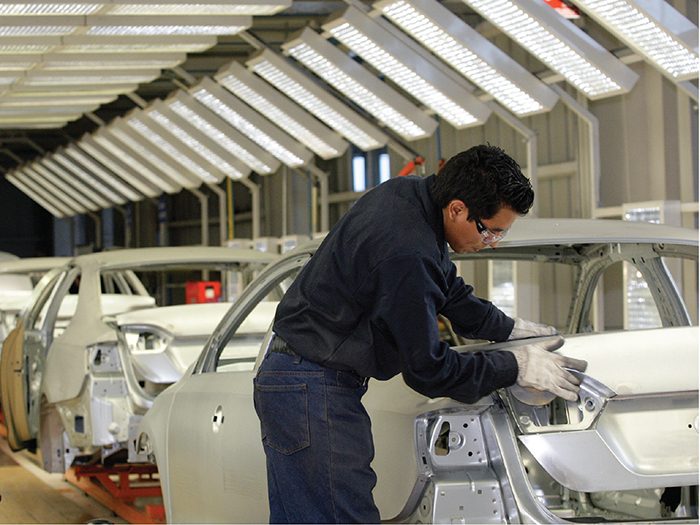Supply Chain Risks
The Risks of Reshoring

President Donald Trump pledged to create millions of jobs in the American economy. To achieve this goal he wants to convince companies to bring back the bulk of their supply chains to the United States.
But promoting the reshoring of manufacturing will be a hard task and, in order to accelerate this process, Trump looks set to experiment with policy measures that should have significant effect on the operations of multinational companies. The government can, for instance, implement tax reforms to reward companies that invest in America, or impose punitive tariffs on goods imported from suppliers located abroad.
Trump can also use his well-known persuasion skills to shame firms into creating jobs at home, rather than elsewhere in the world. The latter strategy may already have borne fruit earlier this year with the likes of Ford Motor Co. and Carrier, which shelved plans to expand their production lines in Mexico, opting to invest in Michigan and Indiana instead.
Either way, the government appears to mean business.
“It does the American economy no long-term good to only keep the big box factories where we are now assembling ‘American’ products that are composed primarily of foreign components,” Peter Navarro, the head of the White House National Trade Council, told the “Financial Times” in January. “We need to manufacture those components in a robust domestic supply chain that will spur job and wage growth.”
“Costs have gone up significantly since the big outsourcing wave started some 15 years ago, and the economic advantages have narrowed.” – J. Paul Dittmann, executive director, Global Supply Chain Institute at the University of Tennessee
If the administration manages to deliver on its promises, companies will have to review the way they deal with supply chain risks. Experts have warned, for example, that workers’ compensation issues could become a more important factor across their supply chain, and insurance programs could become more expensive as insurance coverages tend to be more comprehensive, and premiums higher, in America than in developing nations. But opportunities could also arise, for example in terms of lower transportation costs and proximity to the final consumer.
In fact, although the subject has gained plenty of attention due to the Trump government’s protectionist views, the reversal of the globalization of supply chains has been going on for some time already, said J. Paul Dittmann, the executive director at the Global Supply Chain Institute at the University of Tennessee.
“It is a trend that is already very strong and seems to be growing,” he said. The reasons for this movement are manifold. Higher geopolitical risks have increased the threat of disruption of supply chains around the world in ways that companies did not anticipate some years ago. Dealing with corrupt authorities in the developing world involves plenty of risks of falling afoul with American courts, and economies like China offer less of a cost advantage these days, as income and wage expectations are beginning to catch up with developed economies.
“Costs have gone up significantly since the big outsourcing wave started some 15 years ago, and the economic advantages have narrowed,” Dittmann said. “Many companies have been over-optimistic in their cost analysis, and they often do not fully understand the inventory impact of long distance outsourcing.”
Restructuring Supply Chains
SCM, a think-tank that publishes an annual study on the subject, observed that local-for-local supply chain management strategies have gained popularity among companies since 2012.
Furthermore, the argument that focuses on jobs creation was also played by the Barack Obama administration, and the Economic Development Agency has funded reshoring initiatives for several years already.
That said, Dittmann warned that the movement back to the United States must be a natural one, driven by economic factors, and not by government arm-twisting.
If the authorities want to give the phenomenon a boost, it should address tax and regulatory constraints to the operation of companies in the country, he said.
“To force supply chains into a certain region does not make a lot of sense, and it could put American companies into a position of disadvantage,” he said.
Protective measures could drive production costs up, as wages in America remain much higher than in countries that are vital supply chain markets, such as Mexico or China.
Experts have stressed that industries like consumer electronics, high tech and footwear could suffer considerable impact if restrictive actions are taken against China, while the automotive sector is exposed to any new tariffs on imports from Mexico.
Furthermore, tit-for-tat reactions from foreign governments could restrict the access of American companies to export markets, and retaliation from China would be bad news, for example, for the aerospace industry.
The rise of protectionism, not only in the U.S., but also in Europe and other parts of the world has actually been highlighted by the latest annual report on the matter by the Chartered Institute of Procurement & Supply as a major factor behind an increase in supply chain risks.
The moving of supply chain links from emerging economies to the U.S. should also have a significant effect on the insurance programs of international companies.
It will require them to restructure their programs in order to reflect a broader American footprint, replacing local coverages purchased in foreign markets with others purchased in the U.S., and sometimes acquiring policies that are not really needed in other markets.
That’s the case, for example, with workers’ compensation policies, said Logan Payne, the assistant vice president in Lockton’s global client services group. “In some countries, workers’ compensation is covered by social security systems, while here it is necessary to purchase a separate insurance policy,” he said.
Working mostly in the United States also means that a higher share of a company’s activities will be exposed to a legal system where jury awards are much higher than elsewhere. Therefore, liability programs could become more expensive as local policies purchased abroad are replaced with American ones, Payne said.
The concentration of the supply chain in a single region also means a concentration of business interruption risks. As such, it increases the risk that production will suffer major disruption, if a large event hits one of the supply chain’s links.
On the other hand, risks linked to the shipment and transportation of goods and raw materials should be less of a worry, Payne said.
“With a more regionalized supply chain, where supplies are much closer and there is less need for transoceanic cargo shipment, transportation is one area where insurance costs should be reduced,” he said.
An additional complication is that decisions about supply chains, more than ever, now entail a significant level of reputational risk.
“The basic message is to be more national, don’t just be global,” Richard Edelman, CEO of marketing firm Edelman, told Reuters during the World Economic Forum in Davos.
“Let’s try and pre-empt that tweet by having a long-term discussion about the supply chain.” &











